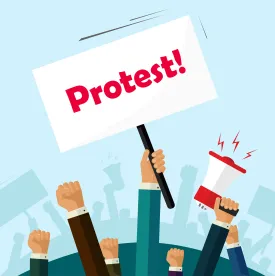For the first time in several years, the version of the FY 2019 National Defense Authorization Act (NDAA) that just passed the Senate does not contain any major reforms to limit bid protests. But the bill the Senate sent to the conference committee process does contain two provisions aimed at bid protests. Although they are minor, they portend and may lay the groundwork for future attempts to change the protest process. Both provisions call for further study of issues addressed in the RAND Corporation’s January 2018 bid protest report.
Protests that are filed first at GAO and then at the Court of Federal Claims
The first bid protest-related provision called for a new study to be carried out by the Secretary of Defense on the “frequency and effects of bid protests involving the same contract award or proposed award” that have been filed both at the Government Accountability Office (GAO) and the Court of Federal Claims (COFC). In recent years, the Department of Defense (DoD) has complained about such protests, even though they are limited in number, and has sought legislation that would force a protester to elect one forum or the other.
The study is to concern the number of such protests, the results, the length of time it took the tribunal to arrive at a decision, and an analysis of any such protests stayed or enjoined. The Secretary is to submit a report on the results of the study, along with “recommendations for improving the expediency of the bid protest process,” within 180 days of the passage of the Act. The RAND report noted it could not “definitively answer” the “rate at which protests appear at both GAO and COFC.” The DoD report recommended by the Senate aims to fill that knowledge gap.
This study seems to be the Senate’s response to a the much more radical provision initially proposed by DoD, which would have amended section 28 U.S.C. § 1491 so that COFC’s timeliness rules followed those at GAO — thereby forcing protesters to select one forum or the other. Currently, COFC does not have the same restrictive timeliness rules as GAO: this allows contractors additional time to file a protest, and also allows protesters dissatisfied with their GAO ruling a second bite at the apple at COFC. According to DoD, these jurisdictional differences between GAO and COFC “greatly hinder[]” the “expeditious resolution” of bid protests.
DoD therefore proposed language requiring post-award protests to be filed at COFC “no later than 10 days after the basis of the protest is known or should have been known.” And, in case DoD’s intent to force protestors to choose between filing at GAO or COFC was not clear, the proposed language also provided that “under no circumstances may the United States Court of Federal Claims consider a protest that is untimely because it was first filed with the Comptroller General.”
This proposal met with opposition from the contractor community. For example, the Professional Services Council (PSC) sent a letter to the Senate Armed Services and Judiciary Committees, in which they strongly opposed the attempt to curtail COFC’s jurisdiction. PSC’s letter referenced the RAND report, and explained that the report had not recommended a drastic change to the existing bid protest system. Instead, the report concluded only that “further research” was needed regarding cases that had been filed at both GAO and COFC. The report did conclude, however, that the “majority” of protests at COFC were resolved within 90 days. That finding does not support DoD’s claim that the “expeditious resolution” of protests is “greatly hindered” by COFC’s current jurisdiction.
It is also worth noting that this was not the first attempt by DoD to place a limit on COFC’s bid protest jurisdiction. In fact, DoD sent identical proposals in both 2013 and 2016. Both of these proposals were rejected by Congress. But although the proposal has now been rejected for the third time, it appears that DoD remains intent on limiting the amount of time within which contractors may seek relief.
Should the current Senate provision pass into law, the outcome of the study will bear close watching. It will surely be used in future discussions about whether to change the current protest system.
Protests of very small procurements
The second bid protest-related provision in the Senate’s FY 2019 NDAA would direct the Secretary of Defense to develop a plan and schedule for an expedited bid process for small value contracts, those valued at less than $100,000. The Senate Armed Services Committee’s (SASC) report on the bill explained that the expedited process would help resolve smaller cases “commensurate with their value while preserving the right to an independent protest.”
This initiative ties directly back to the RAND report, which included the unexpected finding that “roughly 8 percent of GAO protest actions and nearly 4 percent of protest cases at COFC concerned procurements with a declared value under $0.1 million.” The RAND report suggested several possibilities for an expedited process, including COFC ruling from the bench on small-value protests and requiring alternative dispute resolution at GAO. It remains to be seen if the Secretary of Defense’s plan, should the provision survive the committee conference, adopts any of those suggestions.






 />i
/>i

